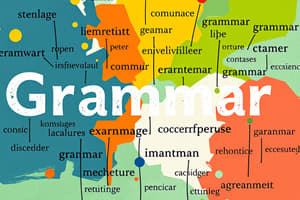Podcast
Questions and Answers
Which of the following is NOT a part of speech?
Which of the following is NOT a part of speech?
- Metaphors (correct)
- Verbs
- Nouns
- Prepositions
English has a total of 44 phonemes.
English has a total of 44 phonemes.
True (A)
Name one genre of literature.
Name one genre of literature.
Fiction
The central argument or claim in a piece of writing is known as the ______.
The central argument or claim in a piece of writing is known as the ______.
Match the following figures to their contributions to the English language:
Match the following figures to their contributions to the English language:
Which type of writing is intended to convince the reader?
Which type of writing is intended to convince the reader?
British English and American English have identical spelling.
British English and American English have identical spelling.
What are the two main influences in second language learning?
What are the two main influences in second language learning?
A ______ is a comparison that does NOT use 'like' or 'as'.
A ______ is a comparison that does NOT use 'like' or 'as'.
What primarily influences the formation of new words?
What primarily influences the formation of new words?
Study Notes
Overview of the English Language
- Origin: Developed from Germanic tribes; heavily influenced by Latin and Norman French.
- Global Use: Widely spoken; considered a global lingua franca.
Phonetics and Phonology
- Phonemes: 44 phonemes; includes vowel and consonant sounds.
- Stress and Intonation: Importance in conveying meaning and emotion.
Grammar
- Parts of Speech:
- Nouns: Names of people, places, things, or ideas.
- Verbs: Express actions or states of being.
- Adjectives: Describe nouns.
- Adverbs: Modify verbs, adjectives, or other adverbs.
- Sentence Structure:
- Simple: One independent clause.
- Compound: Two or more independent clauses.
- Complex: One independent clause and one or more dependent clauses.
Vocabulary
- Word Formation:
- Root Words: Base from which new words are created.
- Prefixes and Suffixes: Added to change meaning or function.
- Types of Words:
- Formal vs. Informal: Usage context affects choice.
- Synonyms and Antonyms: Important for nuance.
Writing
- Types of Writing:
- Narrative: Tells a story.
- Expository: Explains information.
- Persuasive: Convinces the reader.
- Components:
- Thesis Statement: Central argument or claim.
- Body: Supports the thesis with evidence.
- Conclusion: Summarizes and reflects.
Literature
- Genres:
- Fiction: Novels, short stories.
- Poetry: Verses, structured forms.
- Non-Fiction: Essays, biographies.
- Literary Devices:
- Metaphor: Comparison without "like" or "as."
- Simile: Comparison using "like" or "as."
- Imagery: Sensory details to evoke pictures in the reader's mind.
Dialects and Variants
- British English vs. American English: Differences in spelling, vocabulary, and sometimes grammar.
- Regional Dialects: Variations exist within countries; influenced by culture and history.
Language Development
- First Language Acquisition: Natural process occurring in children.
- Second Language Learning: Often influenced by age, exposure, and practice.
Language Change
- Historical Development: Language evolves over time due to social, cultural, and technological influences.
- Modern Influences: The internet and globalization have accelerated changes.
Key Figures in English Language Studies
- William Shakespeare: Influential playwright; expanded the vocabulary of the English language.
- Noah Webster: Introduced American English spelling reforms.
Practical Usage
- Communication Skills: Listening, speaking, reading, and writing are key components.
- Cultural Awareness: Understanding context and culture enhances language use.
Overview of the English Language
- English originated from Germanic tribes, with significant influence from Latin and Norman French.
- It is widely spoken worldwide and often serves as a global lingua franca.
Phonetics and Phonology
- English has 44 phonemes, consisting of distinct vowel and consonant sounds.
- Stress and intonation are crucial for conveying meaning and emotion.
Grammar
- Parts of Speech:
- Nouns represent people, places, things, or ideas.
- Verbs express actions or states of being.
- Adjectives describe nouns.
- Adverbs modify verbs, adjectives, or other adverbs.
- Sentence Structure:
- Simple sentences contain one independent clause.
- Compound sentences combine two or more independent clauses.
- Complex sentences include one independent clause and one or more dependent clauses.
Vocabulary
- Word Formation:
- Root words provide the foundation for new words.
- Prefixes and suffixes are added to alter meaning or function.
- Types of Words:
- Formal versus informal language usage varies based on context.
- Synonyms and antonyms are important for expressing nuanced meaning.
Writing
- Types of Writing:
- Narrative writing tells a story.
- Expository writing explains information.
- Persuasive writing aims to convince the reader.
- Components:
- A thesis statement presents the central argument or claim.
- The body provides evidence to support the thesis.
- The conclusion summarizes and reflects on the main points.
Literature
- Genres:
- Fiction includes novels and short stories.
- Poetry encompasses verses and structured forms.
- Non-fiction includes essays and biographies.
- Literary Devices:
- Metaphor: Comparison without using "like" or "as."
- Simile: Comparison using "like" or "as."
- Imagery: Sensory details to evoke visual pictures in the reader's mind.
Dialects and Variants
- British English and American English differ in spelling, vocabulary, and sometimes grammar.
- Regional dialects exist within countries, influenced by local culture and history.
Language Development
- First language acquisition is a natural process for children.
- Second language learning is influenced by factors like age, exposure, and practice.
Language Change
- Historical development reflects the evolution of language due to social, cultural, and technological influences.
- Modern influences, such as the internet and globalization, accelerate language changes.
Key Figures in English Language Studies
- William Shakespeare, an influential playwright, expanded the vocabulary of the English language.
- Noah Webster introduced spelling reforms for American English.
Practical Usage
- Communication skills like listening, speaking, reading, and writing are essential.
- Cultural awareness enhances language use by understanding context and culture.
Studying That Suits You
Use AI to generate personalized quizzes and flashcards to suit your learning preferences.
Description
Explore the origins, phonetics, grammar, and vocabulary of the English language. This quiz covers the development of English, its global significance, and foundational aspects of phonology and grammar. Test your knowledge on language structure and word formation.




